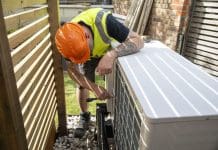Computer scientists at Loughborough University have partnered with engineering consultancy, Cundall, to create an artificial intelligence system that can predict building emissions rates (BER)
Dr Georgina Cosma and postgraduate student Kareem Ahmed of the School of Science, have designed and trained an AI model to predict building emissions rates values with 27 inputs with little loss in accuracy.
The proposed AI model – which was created with the support of Cundall’s head of research and innovation, Edwin Wealend, and trained using large-scale data obtained from UK government energy performance assessments – can generate a BER value almost instantly.
Dr Cosma says the research “is an important first step towards the use of machine learning tools for energy prediction in the UK” and it shows how data can “improve current processes in the construction industry”.
The AI model
In their latest paper, Dr Cosma and the team reveal their AI system can generate building emissions rates for non-domestic buildings in less than a second and with as few as 27 variables with little loss in accuracy.
They used a ‘decision tree-based ensemble’ machine algorithm and built and validated the system using 81,137 real data records that contain information for non-domestic buildings over the whole of England from 2010 to 2019.
The data contained information such as building capacity, location, heating, cooling, lighting, and activity.
The team focused on calculating the rates for non-domestic buildings – such as shops, offices, factories, schools, restaurants, hospitals, and cultural institutions – as these are some of the most inefficient buildings in the UK in terms of energy use.
The project findings were presented at The Chartered Institution of Building Services Engineers (CIBSE) Technical Symposium 2021 and the paper is to be published on CIBSE’s website later this year.
‘Reducing energy consumption and reaching net zero’
Dr Cosma, said: “Studies on the applications of machine learning on energy prediction of buildings exist, but these are limited, and even though they only make up 8% of all buildings, non-domestic buildings account for 20% of UK’s total CO2 emissions.”
Edwin Wealend, added: “Eventually, we hope to build on the techniques developed in this project to predict real operational energy consumption.
“By predicting the energy consumption and emissions of non-domestic buildings quickly and accurately, we can focus our energy on the more important task – reducing energy consumption and reaching net zero.”














